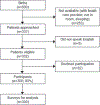Patient Preferences for Prenatal and Postpartum Care Delivery: A Survey of Postpartum Women
- PMID: 32282598
- PMCID: PMC7183878
- DOI: 10.1097/AOG.0000000000003731
Patient Preferences for Prenatal and Postpartum Care Delivery: A Survey of Postpartum Women
Abstract
Objective: To describe patients' preferences for prenatal and postpartum care delivery.
Methods: We conducted a cross-sectional survey of postpartum patients admitted for childbirth and recovery at an academic institution. We assessed patient preferences for prenatal and postpartum care delivery, including visit number, between-visit contact (eg, phone and electronic medical record portal communication), acceptability of remote monitoring (eg, weight, blood pressure, fetal heart tones), and alternative care models (eg, telemedicine and home visits). We compared preferences for prenatal care visit number to current American College of Obstetricians and Gynecologists' recommendations (12-14 prenatal visits).
Results: Of the 332 women eligible for the study, 300 (90%) completed the survey. Women desired a median number of 10 prenatal visits (interquartile range 9-12), with most desiring fewer visits than currently recommended (fewer than 12: 63% [n=189]; 12-14: 22% [n=65]; more than 14: 15% [n=46]). Women who had private insurance or were white were more likely to prefer fewer prenatal visits. The majority of patients desired contact with their care team between visits (84%). Most patients reported comfort with home monitoring skills, including measuring weight (91%), blood pressure (82%), and fetal heart tones (68%). Patients reported that they would be most likely to use individual care models (94%), followed by pregnancy medical homes (72%) and home visits (69%). The majority of patients desired at least two postpartum visits (91%), with the first visit within 3 weeks after discharge (81%).
Conclusion: Current prenatal and postpartum care delivery does not match patients' preferences for visit number or between-visit contact, and patients are open to alternative models of prenatal care, including remote monitoring. Future prenatal care redesign will need to consider diverse patients' preferences and flexible models of care that are tailored to work with patients in the context of their lives and communities.
Figures


References
-
- Osterman MJK, Martin JA. Timing and Adequacy of Prenatal Care in the United States, 2016. Natl Vital Stat Rep 2018;67:1–14. - PubMed
-
- American College of Obsetetricians and Gynecologists. ACOG Committee Opinion No. 736: Optimizing Postpartum Care. Obstet Gynecol 2018;131:e140–e150. - PubMed
-
- Michigan Quality Improvement Consortium. Routine Prenatal and Postnatal Care. Available at: http://www.mqic.org/pdf/2018_mqic_routine_prenatal_and_postnatal_care_cp.... Retrieved May 28, 2019.
-
- Kaiser Permanente Guideline Oversight Group. Prenatal Care Screening and Testing Guideline. Available at: https://wa.kaiserpermanente.org/static/pdf/public/guidelines/prenatal.pdf. Retrieved May 28, 2019.
-
- Viswanathan M, Treiman KA, Kish-Doto J, Middleton JC, Coker-Schwimmer EJ, Nicholson WK. Folic Acid Supplementation for the Prevention of Neural Tube Defects: An Updated Evidence Report and Systematic Review for the US Preventive Services Task Force. JAMA 2017;317:190–203. - PubMed
Publication types
MeSH terms
Grants and funding
LinkOut - more resources
Full Text Sources
Medical

